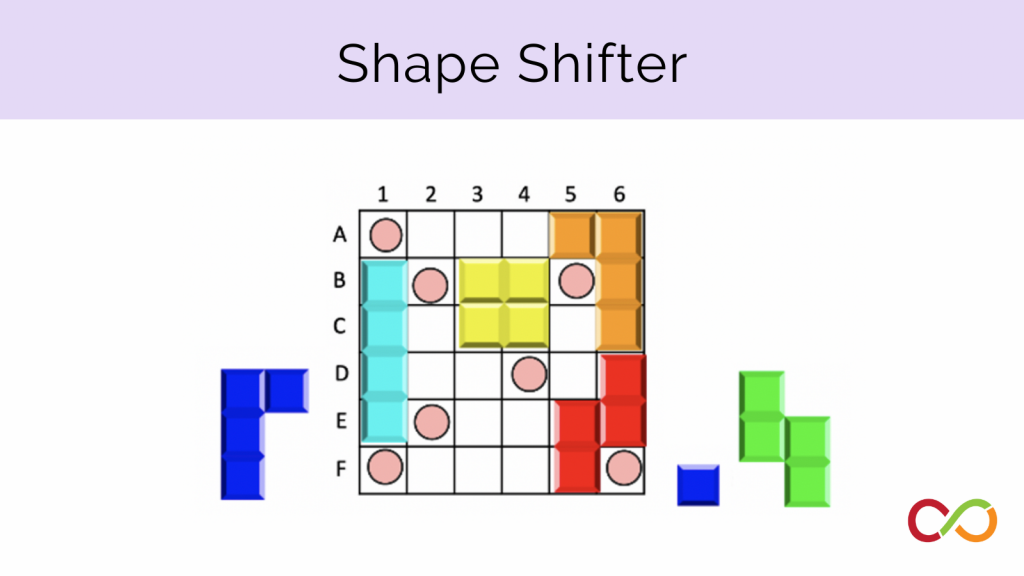The Garden Patio
Early Years (Age 3 – 6)
Curriculum Goal
Kindergarten: Demonstrating Literacy and Mathematics Behaviour
- Measure, using non-standard units of the same size, and compare objects, materials, and spaces in terms of their length, mass, capacity, area, and temperature, and explore ways of measuring the passage of time, through inquiry and play-based learning (#16).
- Describe, sort, classify, build, and compare two-dimensional shapes and three-dimensional figures, and describe the location and movement of objects through investigation (#17).
Context
- Students and the teacher begin by sitting on the floor in a circle.
Materials
- Magnetic square tiles (at least nine single colour tiles per student)
- Pre-cut shapes pasted on cookie sheets (Appendix A)
Lesson
- Explain to students that a sister (Abby) and a brother (Sam) have been asked by their parents to make their own garden patio.
- Hold up the cookie sheet with the two shapes side-by-side and explain that the design on the left (the square) was created by Abby and that the design on the right (irregular shape) was created by Sam.
- Explain that the parents had a disagreement over whether the two garden patios took up the same amount of space.
- Ask children to look closely at the two shapes and try to determine whether the garden patios do in fact take up the same amount of space.
- After hearing several children’s theories ask children, “Is there something you can do to this shape to make it look the exact same as this shape (pointing to the other shape)?”
- Start by focusing on Abby’s patio (the square). Explain that it might be helpful if there was a way to figure out the number of tiles needed to build Abby’s patio.
- Provide each student with a single square tile and their own cookie sheet with the pre-attached shapes placed side-by-side.
- Ask children if there is any way of using the tile to predict the number of tiles needed to fill the entire space.
- Invite students to share their predictions as a whole group or have them whisper their predictions to a neighbour.
- Provide students with two more tiles (each child should have a total of three) and have them use all three to make their predictions of how many tiles are needed to create the garden patio. Let them know that it is okay to change their initial predictions.
- Have children discuss their predictions as a class and share how they came to their conclusions.
- Facilitate discussion to eventually focus on the area of the square which is nine square units.
- Provide each student with nine square tiles and ask them to prove the area of each patio is nine square units. This allows children to see the array in full.
- Now, have students look at Sam’s patio and predict the number of tiles it will take to cover the shape.
- Students may recall that the two shapes can be made to look the same through decomposition/composition and use this information to reason that the irregular shape will also require nine square tiles to fill.
- Have children discuss their predictions and then provide them with nine tiles to cover the irregular shape.
- Facilitate another discussion about how and why the two different shapes contain the same area and can thus be covered with nine square tiles.
Look Fors
- What kinds of strategies are students using? Look for iteration, unitization (do they make a unit of units), seeing structures of rows and columns, different placement of three tiles, etc.
- Are children able to visualize that the irregular patio is the same area as the square? Can they prove it?
Extension
- Ask students to use their nine tiles to create their own shape/patio design.
- Explain that they can design any shape if the tiles are adjoined along their entire edge/side (e.g., tiles cannot be connected at corners or along only a portion of the edge).
- Model an example of a design that conforms to the “all edges must be touching” rule and one that does not.
- Have students share their designs with their classmates.
- To end, have students turn over their trays and reconstruct the original 3 x 3 square.
Share this lesson
Share on facebook
Share on twitter
Share on email

